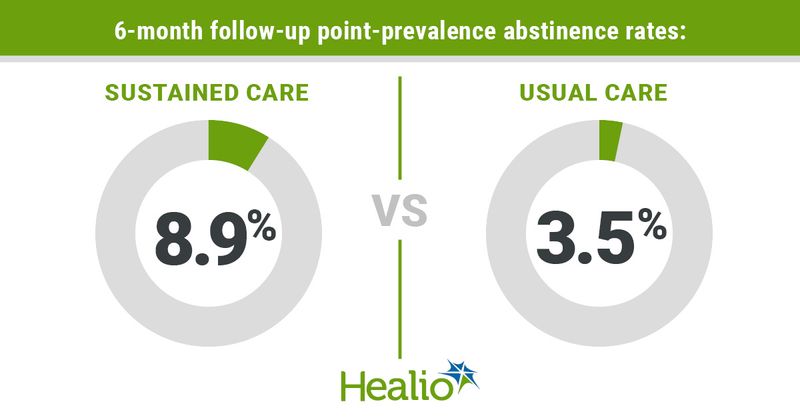Smoking cessation program effective for people with psychiatric disorders post-discharge
A scalable, multicomponent intervention for smoking cessation appeared effective among people with psychiatric disorders following hospital discharge, according to results of a randomized clinical trial published in JAMA Psychiatry.
“Because no tobacco use is allowed on psychiatric hospital units, the inpatient setting offers a unique opportunity to initiate smoking cessation by capitalizing on abstinence already achieved during hospitalization,” Richard A. Brown, PhD, of the School of Nursing at the University of Texas at Austin, and colleagues wrote. “Integration of effective smoking cessation interventions into psychiatric hospitals is a public health priority, accompanied by an important research agenda. As with our [two] prior Helping HAND (Hospital-Initiated Assistance for Nicotine Dependence) trials with adults who were medically hospitalized and smoked, the current trial aimed to capitalize on this largely underused teachable moment by framing a cessation effort as a continuation of what has already begun (ie, a continued move toward total smoking abstinence).”

In the Helping HAND 3 trial, the investigators aimed to compare a multicomponent, sustained care smoking cessation intervention with usual care among adults with serious psychiatric disorders who received inpatient psychiatric care at a single hospital. Usual care consisted of brief smoking cessation information, self-help materials and advice from the admitting nurse, as well as an offer for nicotine replacement therapy during hospitalization. The sustained care intervention consisted of four main elements designed to foster patient engagement with smoking cessation resources after discharge: inpatient motivational counseling; free transdermal nicotine patches on discharge; an option to use a free post-discharge telephone quitline, text-based and/or web-based smoking cessation counseling; and post-discharge automated interactive voice response calls or texts. Biochemically verified 7-day point-prevalence abstinence at 6-month follow-up served as the primary outcome, and smoking cessation treatment use according to self-report at 1, 3 and 6 months following discharge as a secondary outcome.
Brown and colleagues analyzed data of 342 participants (mean age, 35.8 years; 78.4% white) who reported smoking a mean of 16.9 cigarettes daily. Those in the sustained care group had significantly higher 6-month follow-up point-prevalence abstinence rates compared with those who received usual care, for 8.9% vs. 3.5%, respectively (adjusted OR = 2.95; 95% CI, 1.24-6.99). The researchers noted a number needed to treat of 18.5 (95% CI, 9.6-306.4). They confirmed effectiveness via a series of sensitivity analyses. Individuals in the sustained care group more often reported using smoking cessation treatment over the 6 months following discharge than those in the usual care group, for 74.6% vs. 40.5%, respectively (relative risk = 1.8; 95% CI, 1.51-2.25).
“Follow-up research aimed at disentangling effective components of these interventions can aid the goal of establishing an optimized, efficient and effective intervention for smokers hospitalized with psychiatric disorders,” Brown and colleagues wrote. “Also, future research should examine potential differential treatment effects across race/ethnicity and diagnoses.”
